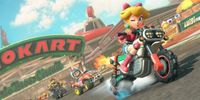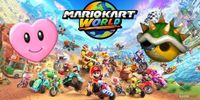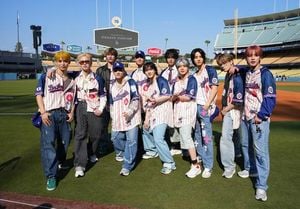Nintendo is gearing up for the release of its latest title, Mario Kart World, set to launch on June 2, 2025, and excitement is palpable among fans. However, the discussion around the game is overshadowed by its controversial $80 price tag, raising eyebrows and stirring debate in the gaming community.
With nearly 30 items confirmed for Mario Kart World, including a mix of new additions and beloved returning staples, the game promises to deliver the chaotic fun that the franchise is known for. Among the returning items are fan favorites like the Mega Mushroom from Mario Kart Wii, the Coin Block, Hammer, and Ice Flower from Mario Kart Tour, while some items, such as the Piranha Plant and Crazy 8, will not be included this time around.
According to reports, some items have been tweaked to suit the game's expanded lobby size and track layout. For instance, the Coin Block now leaves a trail of coins behind after it's used, enhancing the gameplay experience. The Heart Shield, previously exclusive to Peach and Daisy in Mario Kart: Double Dash, has also made a comeback, allowing players to block projectiles and redirect them—an ability that could prove invaluable in a race with over 20 competitors.
Another item making waves is the Bubble from Mario Kart Tour, which protects players from being hit and allows them to traverse any surface without a speed penalty. This could be particularly useful in Mario Kart World, where the expansive courses offer various off-track sections. The Fake Item Box, first introduced in Mario Kart 64, could add a strategic twist by halting players in their tracks, while Donkey and Diddy Kong's Giant Banana could become a formidable obstacle on the wider tracks.
Bowser's Shell, a more lethal version of the Green Shell, is also expected to make an appearance, capable of hitting multiple enemies and ricocheting around the track. This item could drastically alter race dynamics, particularly in a game featuring a larger roster of racers.
While the gameplay mechanics and item lineup are generating excitement, the pricing strategy is causing concern. Speaking to The Washington Post, Nintendo of America President Doug Bowser defended the $80 price tag, stating that the company is implementing a variable pricing strategy. Bowser explained, "What you see right there is variable pricing. We’ll look at each game, really look at the development that’s gone into the game, the breadth and depth of the gameplay, if you will, the durability over time and the repeatability of gameplay experiences. Those are all factors, and there’s many more that go into consideration of what is the right price point for the game. So I think you can anticipate that there will be variable pricing."
This approach has left many gamers feeling uneasy, especially since Nintendo has yet to establish a benchmark for its game prices. The uncertainty surrounding whether prices could rise or fall in the future adds to the anxiety, particularly as pre-orders for Mario Kart World have been stalled in the U.S. Without guarantees that the announced price will remain stable, players are left grappling with the prospect of fluctuating costs.
Bowser’s comments come amid a backdrop of variable pricing across Nintendo's first-party titles, with Mario Kart World, Metroid Prime 4: Beyond, and Donkey Kong Bananza all being released at different price points. While the intent behind variable pricing may be to reflect the individual worth of each game, it raises questions about the long-term implications for the gaming industry.
The gaming community has historically seen prices for blockbuster titles remain relatively stable, but with the introduction of variable pricing, there are fears that it could set a precedent for other publishers to follow suit. If Nintendo's strategy proves successful, it could lead to a future where premium titles are regularly priced at $80 or more, fundamentally changing the landscape of video game pricing.
The conversation around the pricing of Mario Kart World has sparked discussions about the value of games in a rapidly evolving market. As Bowser noted, the industry has seen a significant increase in the number of players and the sales of blockbuster titles, yet the pricing models have not adapted accordingly. This discrepancy raises concerns about whether Nintendo's approach might lead to a broader trend of increasing costs across the industry.
As fans eagerly anticipate the release of Mario Kart World, they are left to wonder if the game's pricing will reflect its value or if it will simply be a harbinger of higher costs to come. The balance between showcasing the quality of gaming experiences and ensuring affordability for consumers remains a delicate one.
In the meantime, Nintendo continues to push boundaries with its innovative gameplay mechanics and item designs, ensuring that the Mario Kart franchise remains a staple in the gaming world. With the promise of exciting new features and a diverse array of items, Mario Kart World is set to deliver a thrilling experience for players, even as the pricing debate looms large.
Ultimately, the success of Mario Kart World may hinge not only on its gameplay and item roster but also on how well Nintendo navigates the complex landscape of game pricing in an increasingly competitive market.





